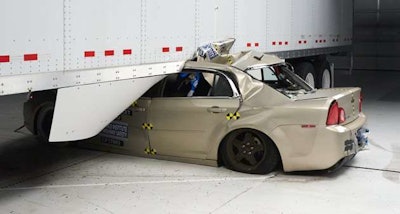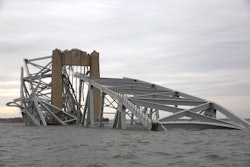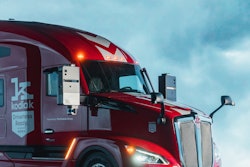
The advisory committee tasked with providing advice and recommendations to the Secretary of Transportation on regulations to reduce underride crashes and fatalities is calling on DOT to strengthen its side underride guard mandate plans and beef up existing rear underride guards, among other things, in a newly published report.
The complete report, not yet released by the National Highway Traffic Safety Administration, was published by Advisory Committee on Underride Protection (ACUP) member Marianne Karth, an advocate for families of underride crash victims.
The committee’s report shows a divide among its 16 members, with a “majority report” section that’s mostly critical of NHTSA’s efforts on enhancing underride safety, and a “minority report” that calls for more research before the DOT moves forward with underride-related regulations.
In addition to analysis and recommendations of underride safety efforts, the committee also raises concern over the alleged suppression of research into underride protection.
The committee’s report references a June 13, 2023, Frontline/ProPublica documentary, America’s Dangerous Trucks, which alleged that a “DOT research report on side guard protections intended to prevent underride fatalities of bicyclists and pedestrians had been heavily edited at the request of trucking industry lobbyists.”
The committee received notarized comments and an offer for testimony from Quon Kwan, a retired Federal Motor Carrier Safety Administration project manager who conceived, proposed and oversaw the research, “to present the findings that DOT removed from the final publication and their potential implications to subsequent cost-benefit analyses. NHTSA did not allow the ACUP to discuss or hear his statement and referred the matter to the Department’s Office of Inspector General,” the committee said.
“It is the assessment of the ACUP that NHTSA excluded relevant data from its cost-benefit analysis for its ANPRM on side impact guards,” the committee said in its report. “Disturbing allegations have been made regarding the potential suppression of or interference with publicly funded side-underride guard research by the Volpe Center that needs to be assessed by an impartial investigator. The fact cannot be ignored that very little has changed regarding side underride guard advancements in the last 50 years and no substantial progress has been made by DOT to prevent these horrific crash fatalities and injuries.” (Emphasis in the original.)
The minority report rebuts the inclusion of Kwan’s letter and related reports in the biennial report, stating that the committee “never considered these reports. Rather, they were sent -- unsolicited -- to [ACUP Chair] Mr. [Lee] Jackson, and he forwarded them to the Committee suggesting that they be considered at the April 24, 2024, meeting.”
The minority group added that “[s]ince NHTSA was not allowed to and did not discuss or consider the material related to Mr. Kwan’s allegations, they cannot be said to be the majority view of the ACUP. Including them in the Biennial Report is improper.”
Rear underride protection
The committee’s report analyzes NHTSA’s 2022 final rule that upgraded standards for rear underride guards on trailers to protect passenger car occupants impacting the rear of trailers at speeds up to 35 mph in crashes in which the passenger car hits the center of the rear of the trailer and in crashes in which 50% of the width of the passenger car overlaps the rear of the trailer.
ACUP was critical of this rulemaking, noting NHTSA didn’t go far enough with the standards. The committee said Congress’ directive to the agency was to meet the testing standards of the Insurance Institute for Highway Safety, which include the 30% overlap scenario instead of the 50% that was finalized.
Instead, the rule “merely requires trailer manufacturers to meet standards that 94% of the industry already voluntarily meet to comply with 2004 Canadian regulations.”
ACUP also claimed that “NHTSA relied upon a number of unsupported assumptions in the final rule to justify its decision not to require protections meeting the 30% overlap scenario.”
The group said the agency “excluded from its cost-benefit analysis the 30% overlap impact protection design marketed by Stoughton Trailers, which the manufacturer claims does not add weight or fuel costs.” NHTSA further said that it didn’t “appear feasible engineering-wise for the additional material … not to add weight or cost to the trailer,” which ACUP said was an “unsupported assertion.”
[Related: NHTSA denies rear-impact guard reconsideration petition from safety coalition]
Side underride protection
NHTSA in 2023 published an advanced notice of proposed rulemaking seeking public input on a potential requirement for trailers to be equipped with side underride guards. In that notice, the agency estimated that there are annually 89 fatalities and 409 serious injuries to light-vehicle occupants in two-vehicle crashes with tractor-trailers where the smaller vehicles strikes the side of a tractor-trailer and underrides it. The ANPRM also estimated a side underride guard mandate would save 17.2 lives and 69 serious injuries annually.
The notice also estimated that side underride guards would add more than 800 pounds to a trailer and upward of $3,000 in additional cost.
[Related: NHTSA safety committee eyes trailer underride retrofit requirement]
The committee cited comments from the Insurance Institute for Highway Safety (IIHS) that identified deficiencies in NHTSA’s research that led the agency “to severely undercount preventable fatalities.” Those deficiencies include the exclusion of multi-vehicle crashes; crashes that involved an initial impact with the passenger vehicle’s side, roof, or any preceding impact with another object; crashes occurring at the 1 o’clock, 5 o’clock, 7 o’clock, and 11 o’clock locations on the tractor-trailer; and more.
ACUP was critical of NHTSA’s ANPRM in a number of areas, including an underestimation of lives that could be saved with side underride guards, the effectiveness of side underride guards, the benefits of cost savings from fuel efficiency attributable to side underride guards and more.
[Related: Side underride guard mandate: Rail disaster waiting to happen?]
Front underride protection
Front underride protection is one area NHTSA has never addressed through rulemaking, ACUP noted. The National Transportation Safety Board in 2010 formally recommended that NHTSA develop performance standards for front underride protection systems for heavy-duty trucks and require that new trucks be equipped with them.
Despite this, NHTSA has not acted on those recommendations, ACUP noted, adding that NTSB rejected a request by NHTSA in 2020 to accept its ongoing research into crash avoidance systems and close the open recommendations due to NTSB’s “concern by the slow pace of your progress.”
In addition to front underride protection, ACUP also highlighted automatic emergency braking (AEB) systems as an "important part of a comprehensive approach to preventing” underride crashes. NHTSA and the Federal Motor Carrier Safety Administration are in the process of developing a final rule requiring AEB on new trucks. The latest Spring 2024 Unified Regulatory Agenda projects a January 2025 publication date for the rule.
[Related: IIHS, Travelers: Truck safety improving but there's still work to be done]
Minority report challenges majority
A minority of ACUP members offered a dissenting opinion that the committee’s report “fails to provide Congress and the Secretary with the requested consensus advice on reducing underride crashes and associated fatalities and injuries.”
While the committee “did offer some recommendations aligned with this goal, most of the Committee’s recommendations as contained in the Biennial Report reflect only the preconceived views and biases of a slim majority of Committee members, who wrote a report that both included significant material never considered by the ACUP in its deliberations and omitted items that did not further the majority’s desired narrative,” the minority group added.
The minority members’ opinion “strongly advocates for objective and evidence-based studies before the Secretary adopts comprehensive underride-related regulations.” They noted that “immediate efforts should focus on obtaining reliable, scientifically-grounded data that accurately describes the scope of the underride problem, the ability to solve that defined problem with available technologies, and the cost of doing so, including costs imposed through unforeseen consequences.”
The minority opinion also calls for more investigation into side underride guards “to assess their effectiveness in preventing fatalities and injuries, as well as the specific crash scenarios leading to those outcomes,” in addition to research into “unforeseen consequences resulting from adopting side-underride guard technology, such as additional fatalities or injuries resulting from damage to trailers, high centering, and increased trips required by cargo displacement.”
Ultimately, the minority members recommend that NHTSA “should prioritize crash-avoidance requirements and distracted-driver mitigation measures to prevent underride accidents proactively.”
Recommendations to DOT
Despite the minority report challenging the majority, ACUP’s recommendations to the DOT include, but are not limited to:
- NHTSA should withdraw or reissue a revised ANPRM on side underride guards “that acknowledges and accommodates critiques made by commenters that the cost-benefit approach taken artificially constrained the number of lives saved and also failed to account for cost-savings (such as fuel efficiency gains provided by side underride guards)”
- NHTSA should require all new semitrailers and single-unit trucks that have crash-incompatible open spaces to be equipped with side underride guards
- NHTSA should require semitrailers and single-unit trucks manufactured after 1998 to be retrofitted with side underride guards
- Amend the 2022 rear underride final rule to require that all new trailers meet the IIHS TOUGHGUARD test protocol or equivalent, which includes the ability to withstand a 30% rear overlap crash at 35 mph
- All trailers manufactured between 1998 to the current time that do not have IIHS TOUGHGUARD awarded rear impact guards should be retrofitted with crash-proven reinforcement devices
- FMCSA and NHTSA must expeditiously complete the AEB rulemaking for all classes of commercial motor vehicles
- FMCSA should issue stronger conspicuity tape requirements, at a minimum, a requirement to maintain and replace conspicuity tape every 5 years
- NHTSA should issue an ANPRM on front impact guards
- NHTSA should expeditiously conduct rear impact guard testing at “highway speeds” (up to 65 mph) as already directed by Congress and publish the results within two years
- NHTSA should conduct a study to research how the survivability rate of rear underride crashes will change with increased passenger vehicle adoption of AEBs at currently tested speeds (35 mph) as well as highway speeds (up to 65 mph)
- NHTSA should conduct comprehensive research on U.S. underride crash characteristics, including the frequency of 30% overlap crashes
- DOT should continue research into Enhanced Rear Signaling Systems that could help better prevent rear underride crashes
- DOT should research the efficacy of high visibility Clearance Lamps that illuminate the rear of a CMV to assist with potential Clearance Lamp rulemaking for all CMVs
- DOT should conduct research into efficacious methods of reducing distracted Driving, such as flashing lamps
[Related: Side underride guards the most expensive mandate in trucking history?]













